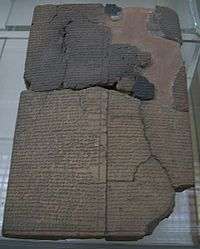Hattusili III
| Hattusili | |
|---|---|
| King of Hatti | |
| Reign | ca.1267 – 1237 BCE |
| Predecessor | Mursili III |
| Successor | Tudhaliya IV |
| Consort |
Puduhepa Babylonian Princess |
| Issue |
Nerikkaili Tudhaliya IV Maathorneferure[1] Kiluš-Ḫepa[2] Gaššulawiya |
| Father | Mursili II |
| Mother | Gassulawiya |
| Religion | Hittite religion |
Hattusili III (Hittite: "from Hattusa") was a king of the Hittite empire (New Kingdom or Late Empire) ca. 1267–1237 BC (short chronology timeline).[3]
Family

Hattusili was the fourth and last son of Mursili II.[4] His mother was Queen Gassulawiya and his brother was Muwatalli II.[5]
Hattusili married Puduhepa, a priestess of Ishtar, who later became the Hittite queen.[6][7]
| Hittite New Kingdom royal family tree | |
|---|---|
| |
References:
| |
Notes:
|
Biography
Mursili appointed Hattusili as a priest of Sausga of Samuha, and Hattusili remained loyal to the Ishtar of Samuha to the end of his days.
His older brother Muwatalli moved his seat in Tarhuntassa and appointed him governor of Hattusa.
Hattusili was a commander of the Hittite forces during the famous Battle of Kadesh against Egypt in 1274 BC. Hattusili reconquered Nerik and became the high priest of its storm god. Hattusili named his eldest son and crown prince Nerikkaili in honor of this achievement.[8]
His nephew Mursili III (or Urhi-Teshub) moved the capital back to Hattusa (KBo 21.15 i 11-12), rendering Hattusili’s governorship redundant. Mursili then deposed him from Nerik, triggering a civil war. Hattusili defeated and exiled his nephew. Hattusili renamed Urhi-Teshup’s sibling Ulmi-Teshup "Kurunta" and appointed Kurunta over Tarhuntassa in his place. After this, Hattusili elevated a junior son Tudhaliya IV as crown prince instead.
Hattusili and the Egyptian pharaoh Ramesses II sealed a written peace treaty based upon Hittite models which, due to Egyptian monumental copies of it, has become the earliest well-known treaty in history, establishing a long-lasting peace between the two rival empires. Ramesses married Hattusili’s daughter, and conferred upon her an Egyptian name, Maathorneferure.[9] Years later he married another Hittite princess.[10]
An archive of over 200 letters have been found from the royal palace at Hattusa which show that Hattusili exchanged letters with numerous Near Eastern kings including Ramesses II. They are an important primary source for this period.
See also
References
- ↑ Dodson, Aidan; Hilton, Dyan (2004). The Complete Royal Families of Ancient Egypt. Thames & Hudson. p. 140. ISBN 978-0-5000-51283.
- ↑ Singer (1991) 327f.
- ↑ Bryce, Trevor (1998). The Kingdom of the Hittites. Oxford University Press. ISBN 978-0-19-924010-4., pp.xiii-xiv
- ↑ Trevor Bryce, Life and society in the Hittite world. Oxford University Press, 2002. ISBN 0-19-924170-8
- ↑ Edel, E., (1994): Die ägyptisch-hethitische Korrespondenz aus Boghazköi in babylonischer und hethitischer Sprache
- ↑ Darga, Muhibbe. Women in the Historical Ages. In Women in Anatolia, 9000 Years of the History of the Anatolian Woman, Turkish Republic Ministry of Culture, Istanbul, 1993, page 30.
- ↑ Letter from Ramses II of Egypt to Puduhepa, from Women in Anatolia, 9000 Years of the History of the Anatolian Woman, Turkish Republic Ministry of Culture, Istanbul, 1993.
- ↑ Apology of Hattusili III
- ↑ Wilkinson, Toby (2011). The Rise and Fall of Ancient Egypt. Bloomsbury. pp. 340–41. ISBN 978-1-4088-1002-6.
- ↑ J.H. Breasted, Ancient Records of Egypt, Part Three, § 415ff.
External links
- Reign of Hattusili III
- The Eternal Treaty from the Hittite perspective by Trevor Bryce, BMSAES 6 (2006), pp. 1–11
| Regnal titles | ||
|---|---|---|
| Preceded by Mursili III |
Hittite king ca. 1267–1237 BC |
Succeeded by Tudhaliya IV |
| ||||||||||||||||||||||||||
|